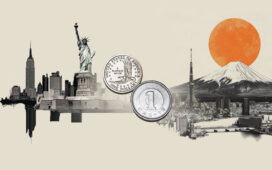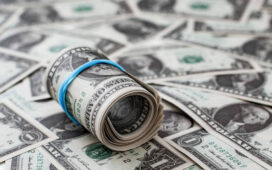The Indian Rupee (INR) struggles to gain ground against the US Dollar (USD) during late Indian trading hours on Wednesday. The USD/INR pair trades slightly higher to near 88.40 as the US Dollar trades higher ahead of the Federal Reserve’s (Fed) monetary policy announcement at 18:00 GMT.
At the time of writing, the US Dollar Index (DXY), which tracks the Greenback’s value against six major currencies, trades 0.25% higher to near 99.00.
According to the CME FedWatch tool, traders have priced in a 25-basis-point (bps) interest rate reduction by the Fed that will push the Federal Fund rate to 3.75%-4.00%. Therefore, the major trigger for the US Dollar will be monetary policy guidance by the Fed for the last policy meeting of the year in December.
Market participants expect the Fed to deliver a dovish stance on the monetary policy outlook as the impact of US tariffs on inflation has not appeared to be persistent, labor market conditions continue to deteriorate, and the federal shutdown enters its fourth week.
The US Consumer Price Index (CPI) data for September showed on Friday that monthly headline and core inflation grew moderately by 0.3% and 0.2%, respectively. The same day, the flash S&P Global PMI report for October showed that while employment growth picked up, the pace of job creation remained only modest, and weakened especially in manufacturing. Job growth was limited by a worsening of business confidence, principally reflecting ongoing concerns over the impact of government policies such as tariffs.
Daily digest market movers: Trump-Xi meeting to be key trigger for global sentiment
- The Indian Rupee struggles to recover against the US Dollar even as overseas investors pump significant capital into the Indian stock market on Tuesday. Foreign Institutional Investors (FIIs) bought Rs. 10,339.80 crores worth of equity shares on Tuesday, the highest amount of one-day purchase seen in a few months.
- In the July-September period, FIIs sold shares worth Rs. 1,29,870.96 crores in the Indian equity market. The major reason behind the outflow of a significant chunk of foreign flows was trade frictions between the US and India.
- US President Donald Trump raised tariffs on imports from India to 50% as a penalty for buying oil from Russia. Trump criticized India for buying Russian oil, stating that money flowing to Moscow against energy sales is being utilized to fund the war in Ukraine.
- Meanwhile, easing trade tensions between the two nations has improved foreign investors’ sentiment towards India. This weekend, a Bloomberg report showed that negotiators from both nations have agreed on almost all issues, and a deal could be announced soon.
- On the global front, investors await the high-stakes trade talks between US President Trump and Chinese leader Xi Jinping in South Korea on Thursday. Ahead of the meeting, Trump has expressed that fentanyl-tied tariffs imposed on Beijing would come down. “I expect to be lowering that because I believe they’re going to help us with the fentanyl situation,” Trump said to reporters at Air Force One.
- Earlier this week, US Treasury Secretary Scott Bessent also expressed confidence that 100% additional tariffs recently imposed by Washington on Beijing would be rolled back, and China might also defer rare-earth export controls.
The table below shows the percentage change of Indian Rupee (INR) against listed major currencies today. Indian Rupee was the strongest against the British Pound.
| USD | EUR | GBP | JPY | CAD | AUD | INR | CHF | |
|---|---|---|---|---|---|---|---|---|
| USD | 0.26% | 0.50% | 0.15% | -0.01% | -0.14% | 0.03% | 0.43% | |
| EUR | -0.26% | 0.25% | -0.09% | -0.26% | -0.39% | -0.21% | 0.18% | |
| GBP | -0.50% | -0.25% | -0.32% | -0.50% | -0.64% | -0.47% | -0.06% | |
| JPY | -0.15% | 0.09% | 0.32% | -0.16% | -0.29% | -0.13% | 0.28% | |
| CAD | 0.00% | 0.26% | 0.50% | 0.16% | -0.14% | 0.03% | 0.44% | |
| AUD | 0.14% | 0.39% | 0.64% | 0.29% | 0.14% | 0.17% | 0.57% | |
| INR | -0.03% | 0.21% | 0.47% | 0.13% | -0.03% | -0.17% | 0.39% | |
| CHF | -0.43% | -0.18% | 0.06% | -0.28% | -0.44% | -0.57% | -0.39% |
The heat map shows percentage changes of major currencies against each other. The base currency is picked from the left column, while the quote currency is picked from the top row. For example, if you pick the Indian Rupee from the left column and move along the horizontal line to the US Dollar, the percentage change displayed in the box will represent INR (base)/USD (quote).
Technical Analysis: USD/INR trades cautiously around 20-day EMA
-1761717451086-1761717451090.png&w=1536&q=95)
USD/INR retreats to near 88.30 on Wednesday. The pair struggles to return above the 20-day Exponential Moving Average (EMA), which trades around 88.41.
The 14-day Relative Strength Index (RSI) recovers sharply from 40.00, suggesting buying interest at lower levels.
Looking down, the August 21 low of 87.07 will act as key support for the pair. On the upside, the all-time high of 89.12 will be a key barrier.
Fed FAQs
Monetary policy in the US is shaped by the Federal Reserve (Fed). The Fed has two mandates: to achieve price stability and foster full employment. Its primary tool to achieve these goals is by adjusting interest rates.
When prices are rising too quickly and inflation is above the Fed’s 2% target, it raises interest rates, increasing borrowing costs throughout the economy. This results in a stronger US Dollar (USD) as it makes the US a more attractive place for international investors to park their money.
When inflation falls below 2% or the Unemployment Rate is too high, the Fed may lower interest rates to encourage borrowing, which weighs on the Greenback.
The Federal Reserve (Fed) holds eight policy meetings a year, where the Federal Open Market Committee (FOMC) assesses economic conditions and makes monetary policy decisions.
The FOMC is attended by twelve Fed officials – the seven members of the Board of Governors, the president of the Federal Reserve Bank of New York, and four of the remaining eleven regional Reserve Bank presidents, who serve one-year terms on a rotating basis.
In extreme situations, the Federal Reserve may resort to a policy named Quantitative Easing (QE). QE is the process by which the Fed substantially increases the flow of credit in a stuck financial system.
It is a non-standard policy measure used during crises or when inflation is extremely low. It was the Fed’s weapon of choice during the Great Financial Crisis in 2008. It involves the Fed printing more Dollars and using them to buy high grade bonds from financial institutions. QE usually weakens the US Dollar.
Quantitative tightening (QT) is the reverse process of QE, whereby the Federal Reserve stops buying bonds from financial institutions and does not reinvest the principal from the bonds it holds maturing, to purchase new bonds. It is usually positive for the value of the US Dollar.
foreign investors’ sentiment



